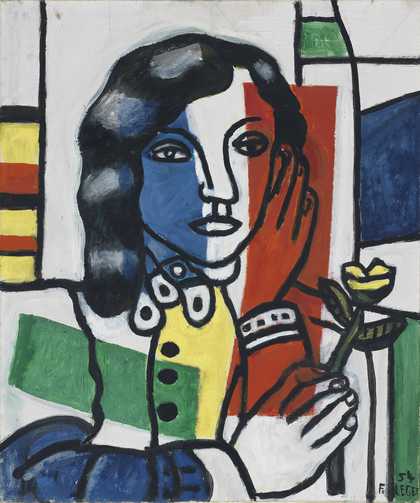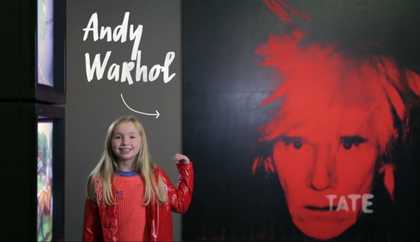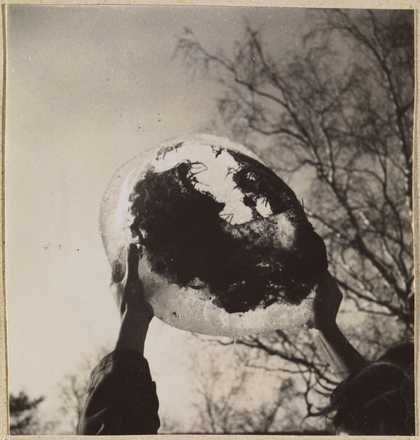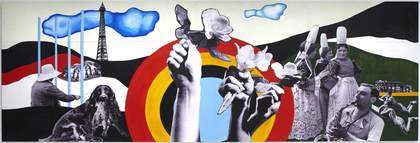
Fernand Léger and Charlotte Perriand
Essential Happiness, New Pleasures. Pavilion of Agriculture, Paris, International Exhibition 1937–2011
Museo Nacional Centro de Arte Reina Sofía
© ADAGP, Paris and DACS, London 2018. Photographic Archives Museo Nacional Centro de Arte Reina Sofia
Let us gaze wide-eyed at present-day life, which rolls, moves, and over-flows alongside us
Fernand Léger
Fernand Léger was a French artist who worked in many mediums, including film and graphics. What he is best known for, though, are his large scale paintings and murals. Often painted in block colours with bold graphic lines, they are evidence of his belief that 'color is… as indispensable to life as water or fire'.
Léger’s treatment of modern subject matter was way ahead of its time, paving the way for contemporary art. What was most groundbreaking was the way in which he gave equal value to objects as to living things, a quality which would eventually characterise the Pop Art movement.
Fernand Léger: New Times, New Pleasures is on at Tate Liverpool 23 November 2018 – 17 March 2019
1. He was a forerunner of Pop Art
[Léger is] a man so steeped in the world around him that his art cannot be separated from contemporary vision
Katherine Kuh, MoMa, 1953
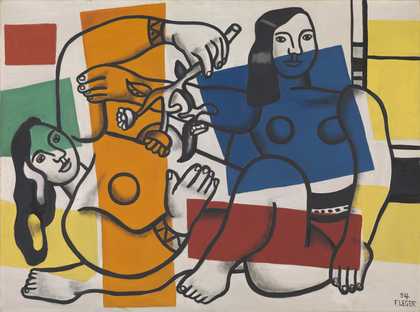
Fernand Léger
Two Women Holding Flowers 1954
Tate
© ADAGP, Paris and DACS, London 2018
Léger is one of the first artists to begin using the subject matter of consumer society in his work. His paintings feature flattened people riding bicycles, machines, house plants, chairs and bottles of wine in bold block colour. These works preempt a style that would later be used by many pop artists . This is emphasised by his graphic use of line, fascination with machines and flattened, expressionless figures.
Léger was impressed by the modern city with its advertising, artificial lights and methods of transportation. He explores this in his 1924 essay ‘The Spectacle’, which discusses his views on modernity.
The rhythm [of the modern world] is so dynamic that a ‘slice of life’ seen from a cafe terrace is a spectacle… On the boulevard two men are carrying some immense gilded letters in a handcart; the effect is so unexpected that everyone stops and looks.
Finding new ways to convey the vibrant rush of modern life became a passion which can be seen in much of his work.
2. He loved the circus
Go to the circus... It is so human to break through restraints, to spread out, to grow toward freedom… To escape from the ground, to leave it, to touch the tip as little as possible, the farthest tip
Excerpt from the introduction of ‘Cirque’, his 1950 folio of lithographs
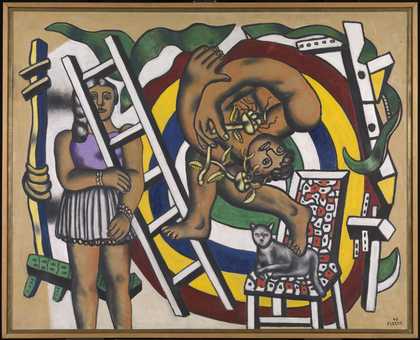
Fernand Léger
The Acrobat and his Partner (1948)
Tate
The circus provided Léger with an endless source of inspiration and joy throughout his lifetime. As a child the circus passed through his hometown in the French countryside. This was followed by attendance at the Cirque Médrano of Montmartre during his time in Paris, and later at the Ringling Bros. and Barnum & Bailey circuses in the United States. The wealth of colour and movement that each performance offered, was the perfect subject matter for a man so passionate about the pace and brilliance of the modern world.
When I am lost in this astonishing metallic planet, with its dazzling spotlights and the tiny acrobat who risks his life every night, I am distracted.
His painting The Acrobat and His Partner is an example of this. The swirling movement of the acrobat is juxtaposed with the stillness of his partner who attentively holds the ladder. This is a balancing act between what he called ‘the dynamic and the static’.
3. The war changed his art
My experiences at the front and the daily contact with machines led to the change which marked my painting
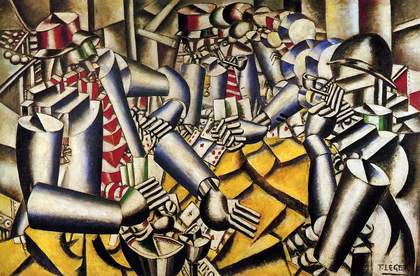
Fernand Léger
Soldiers Playing Cards 1917
Kröller-Müller Museum
From 1914 to 1917 Leger fought on the front-line at Argonne and Verdun. Afterwards he reflected on his experience:
...I was stunned by the sight of the breech of a 75 millimeter in the sunlight. It was the magic of light on the white metal... The crudeness, variety, humor, and downright perfection of certain men around me, their precise sense of utilitarian reality and its application in the midst of the life-and-death drama we were in ... made me want to paint in slang with all its color and mobility.
This marked a significant change in the work he was making. From abstract and cubist works, he transitioned to what became known as his ‘mechanical period’. Industrial and machine-like objects came to the forefront of his artwork.
I wanted brightness and intensity, so I used the machine, as others use the nude or the still life.
4. He invented Tubism
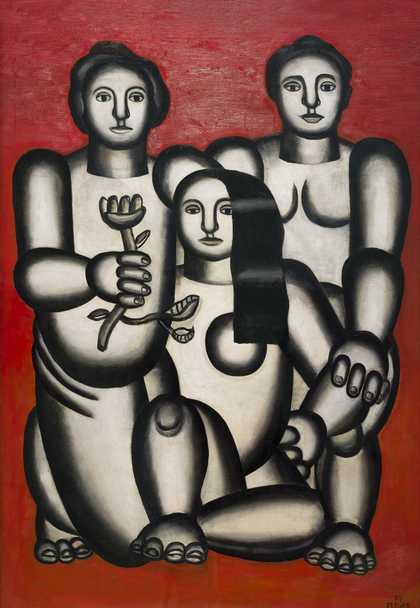
Fernand Léger
Trois femmes sur fond rouge 1927
Musée d'art moderne et contemporain de Saint-Étienne Métropole
© ADAGP, Paris and DACS, London 2018. Image courtesy Cyrille Cauvet/Musée d’art moderne et contemporain de Saint-Étienne Métropole
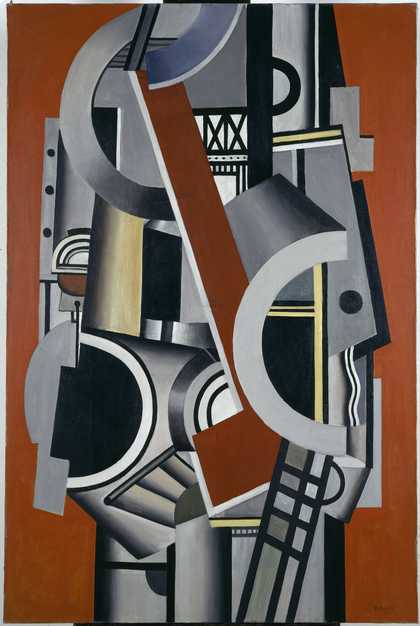
Fernand Léger
Elément mécanique 1924
Centre Pompidou - Musée national d'art moderne - Centre de création
industrielle
© ADAGP, Paris
Léger isolated elements of the image and fragmented it to show different viewpoints. This is very characteristic of Cubism. However, his take on this technique was so unique that many felt it needed a different name. The bold, simple forms he used were reminiscent of the industrial world and often did not depict a clear subject matter, as many Cubist paintings did.
Because his artworks featured cylindrical forms, the art critic Louis Vauxcelles coined the term ‘Tubism’ to describe it. This style of painting is perhaps evidence of his structural view of the world. A view inspired by the mechanical tools of war and his architectural training.
5. He believed that art is for everyone
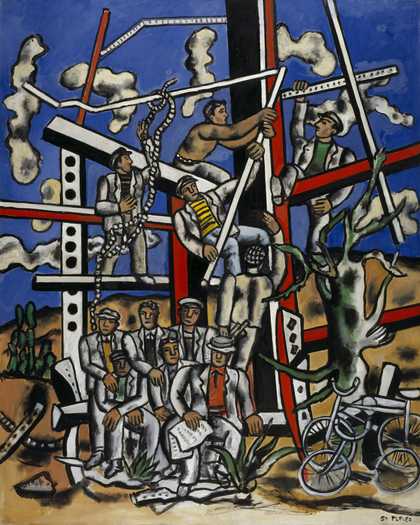
Fernand Léger
Study for 'The Constructors': The Team at Rest 1950
Scottish National Gallery of Modern Art
© ADAGP, Paris and DACS, London 2018. Photo: Antonia Reeve
Léger was a socialist. He believed the primary purpose of making art is to enrich the lives of everybody in society. In order to bring art into people’s everyday lives he worked on posters and murals as well as on the easel. His paintings depict construction workers and people enjoying leisure activities. These everyday scenes are reflected back to us in a new light and the characters are given dignity in their normality.
Léger carried this life view through to his teaching. He taught throughout his life and many of his students went on to make waves in the art world. People such as Saloua Raouda Choucair, Louise Bourgeois, William Klein, Tarsila Do Amaral and Marlow Moss all graduated from his classes.
Fernand Léger: New Times, New Pleasures is on at Tate Liverpool 23 November 2018 – 17 March 2019

